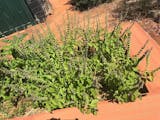The biennial yellow beetroot 'Burpees Golden' is a popular and long-kept kitchen treasure and tastes unmistakably pleasantly sweet, juicy and fruity. Excellent for raw food. Ideal for pre-cultivation, pot cultivation possible, sowing all year round, good for mixed culture, harvesting the roots.
Description
The yellow beetroot 'Burpees Golden' is a very old, fast-growing and biennial root vegetable that originally comes from the Mediterranean region and has been cultivated year-round in Europe since the 16th century. The original form of the beetroot [Beta vulgaris] was cultivated and used as early as 2000 BC. In America and England, this variety is a long-kept and popular kitchen treasure. The variety develops healthy green foliage with yellow leaf veins. The visually unique golden-yellow colored round beets with striking bright white rings are derived from the white beetroot and grow just as robustly and are resistant to drought. The special taste is unmistakably pleasantly sweet, juicy and fruity and is much sweeter than the red beetroot. Excellent as a raw food, for juicing or in smoothies. For year-round cultivation.
General information
Plant family: Amaranthaceae
Life cycle: Biennial
Days to harvest: 80 days
Plant height approx.: 40 cm
Root type: Deep rooter
Nutrient requirements: Medium
Water requirements: Medium
Winter hardiness: Up to -5°C
Location: Sunny
Soil: Permeable, loamy, humus
pH value: 6 to 7
Sowing and planting information
Germination type: Dark germinator
Sowing depth: 1-2 cm
Optimal germination temperature: 18-22 °C
Germination time: 7-10 days
Plant and row spacing: 15x30 cm
Germination ability of seeds: 5-6 years
Mixed culture
Optimal mixed culture: Bean, Savory, Dill, Cucumber, Garlic, Cabbage, Parsnip, Broad bean, Onion
Unfavorable mixed culture: Potatoes, Leeks, Corn, Chard, Spinach
Sowing by climate zone
Subtropic climate (Mediterranean) (e. g. B. Portugal, Spain, Italy)
Direct sowing is possible all year round. Pre-cultivation in small bowls is recommended. The plants are ideally placed in a sunny or partially shaded location.
Moderate climate (e. g. B. Germany, Switzerland, Poland)
Direct sowing is possible from March to August. Pre-cultivation in small bowls is recommended. The plants should ideally be planted in a sunny location.
General recommendations
For pre-cultivation, sow the seeds in a small bowl and let the seedlings grow until the first visible beet leaves appear, then transplant them into the desired container. After transplanting, let the seedlings grow at moderate temperatures until they are ready to be planted out as seedlings. Plant the seedlings in the bed from the second pair of leaves after the cotyledons.
Yellow beet 'Burpees Golden' ideally prefers a soil that is moist, permeable, nutrient-rich and contains plenty of humus and loam. It does not tolerate waterlogging.
Additional tips
For a staggered harvest, several sowings at intervals of 4 weeks are recommended. Heat-resistant, bolt-resistant, germinates successfully even in warm temperatures. In order to quickly obtain a fine, crumbly and permeable soil with good nutrient and water storage capacity, additional incorporation of biochar and primary rock flour is recommended.
Type of propagation
Propagation occurs via seeds.
Plant care
Loosened, nutrient-rich soil and mixed planting are sufficient for beets. No fertilization is necessary.
Other names
Botanical names: Beta vulgaris
English names: Beetroot, Red beet, Garden beet, Table beet
German names: Bete, Rande, Rübe
Portuguese names: Beterraba, Raiz de beterraba
Spanish names: Betabel, Betarava, Betarraga, Betaraba
French names: Betterave, Betterave rouge
Origin
Country: Portugal



![Yellow Beetroot Burpees Golden [Beta vulgaris]](http://www.benjis.net/cdn/shop/files/GelbeBeteBurpeesGolden-Yellowbeetroot-Beterrabaamarela-Betavulgarisconditiva-www.benjis.net.jpg?v=1707390218&width=1445)





